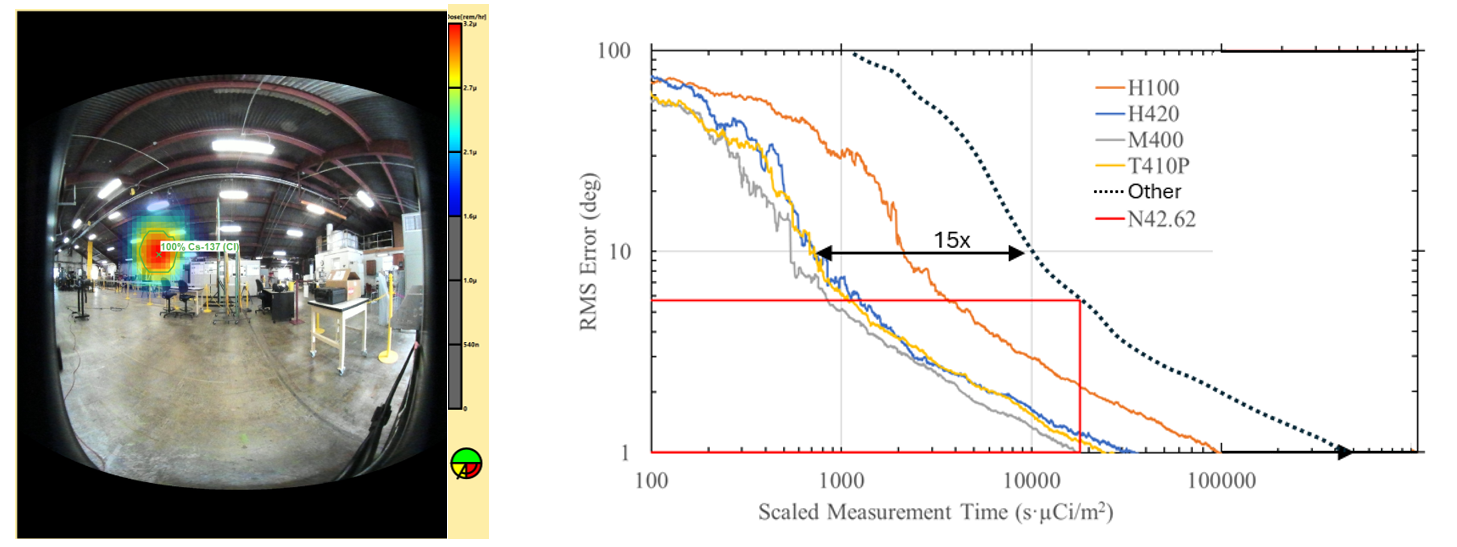Comparing Gamma-Ray Imager Performance
Detectors ranging from scintillators, to CdZnTe, and HPGe are used for gamma-ray imaging. Each detector type has pros and cons, such as active volume, resolution, ruggedness, power, and price. CdZnTe detectors fill a sweet spot, providing high-resolution spectra in a rugged, room-temperature-operation package. However, not all CdZnTe-based gamma-ray imagers are comparable. Crystal size can vary by orders of magnitude across product types. Readout rates can further impact the efficiency of imagers with ostensibly high active volumes. An efficiency comparison between two gamma-ray imagers is shown in Figure 1. Photopeak amplitudes for systems whose active volumes are within a factor of two vary by fifteen times! These differences stem from energy resolution and readout constraints, particularly at high energies. High-energy efficiency is particularly important in nuclear power applications, where 60Co non-negligibly contributes to worker dose and in CBRNE applications where sources are often shielded, requiring detection of higher-energy photons.

Figure 1: Comparison of H420 and an alternative CdZnTe-based gamma-ray camera for 133Ba (top), 137Cs (middle), and 60Co (bottom). Photopeak count ratios of H420 to alternative for each source (356, 662, and 1330 keV) are roughly fifteen to one. "Other camera" data taken from [1].
Gamma-ray spectral and imaging efficiency is critically important for tasks set out in the Passive Imaging Radiation Devices (PIRDs) N42.62 standard. For example, Section 6.4 tests the source localization accuracy of gamma-ray imagers. Irradiations occur at 2.8 µR/h of 137Cs for 30 minutes where an H420 records roughly 2000 photopeak and 500 photopeak imageable counts. A well-converged H420 reconstruction from the Section-6.4 scenario is shown in Figure 2. Assuming equivalent imaging efficiencies, the other camera discussed in Figure 1 would only record 130 photopeak and 30 photopeak imageable counts. Source localization using 30 imageable counts is borderline failing the 5.6-degree localization error dictated in Section 6.4 and shown in Figure 2 [2]. As such, both the spectral and imaging efficiency provided by the H420 gamma-ray imaging spectrometer are critical for real-world PIRD tasks.

Figure 2: (Left) H420 Compton reconstruction of 137Cs events in the N42.62 Section 6.4 test. Note the well converged hotspot reconstructed in the true location. (Right) Comparison of H3D, Inc. products and other system assuming comparable imaging efficiency and reconstruction algorithms. Note that is dangerously close to failing the N42.62 metric.
References:
[1] M. Risse et al., "Gamma Camera - advantages and limits identifying sources over a broad energy range," INMM Conference 2024.
[2] C. Wahl and D. Goodman, "Practical Gamma-Ray Imager Performance Characterization," in IEEE RSTD/NSS Conference 2024.
Contact H3D directly for more information about CdZnTe-based gamma-ray spectroscopy and imaging.